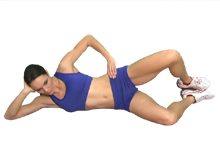Today’s guest post is an interesting topic by Heidi Mills from the Sports Injury Clinic in the UK, asking if we should be treating male and female patients with patellofemoral syndrome differently. The basis of the post comes from a recent journal publication showing different running mechanics between gender. I am a firm believer that each person should have an individualized program based on their specific biomechanics and examination, meaning that we WOULD treat them differently – not because of gender itself, but because of the biomechanical differences between the genders.
Are Mechanics Different between Male and Female Runners with Patellofemoral Pain

The authors analysed the gait cycle and single leg squat movement in 18 female and 18 male runners with PFPS as well as 18 male runners without knee pain. Results showed that men with PFPS ran and squatted with an increased knee adduction and external rotation than men without knee pain. Men with knee pain also demonstrated less hip adduction but more peak knee adduction that female runners with PFPS.
To simplify, in those men with knee pain, the knee joint falls in and rotates outwards more than in those without knee pain. In comparison with women who suffer knee pain, men’s thighs fell in less but the knee joint itself underwent more knee adduction (between the Tibia and Femur bones).
The authors concluded that these differences in mechanics between men and women warrant that PFPS treatments be gender specific.
Clinical Applications
Based on this information, should we be treating men and women differently? Or is it more accurate to assess each individual as a separate entity regardless of their sex?
My personal opinion is that gender should not be a leading influence on treatment protocols. Each person should be evaluated independently to determine their specific movement patterns, muscle imbalances, injury history and sporting / training techniques and how these factors all combine to cause the pain in question. If this is all evaluated thoroughly then their gender is largely irrelevant. Treatment should focus on the findings of the assessment, not what research suggests may be causing the injury due to the patient’s sex alone.
Based on this study, it appears that there may be gender based biomechanical differences, but a proper evaluation must be performed for each patient. We can use information like this to help streamline our diagnostic process.
Treatment Considerations
What can be taken from the results of this research is that hip adduction, knee adduction and knee external rotation may be contributing factors for patellofemoral pain sufferers. Treatment should be as individual as the patient and address their specific problems.

Those with excess knee adduction and external rotation should be examined for overpronation at the sub-talar joint, which can result in these movements. Overpronation can be corrected with orthotics in day-to-day footwear and specialist running shoes.
Hamstring length tests should also be administered, as a tight Biceps Femoris muscle could increase external knee rotation. If this is the case then hamstring stretches and massage may be effective.
Other common factors include tight lateral Quads, IT bands and hip adductors which can be corrected with quad and groin stretches, self-myofascial release (using a foam roller, or similar) and sports massage.
A weakness or delayed firing of the vastus medialis oblique muscle can also be to blame as it fails to counteract the stronger pull of the tight lateral structures. Re-training of this muscle can be performed initially in a seated position (with 10° knee flexion) and progressed to a standing position.
These are all potential things that we could look at when evaluating and designing a program for someone with patellofemoral pain syndrome.
Learn more about patellofemoral pain syndrome from SportsInjuryClinic.net. Also, RehabWebinars.com has a couple of great webinars on the Biomechanics of Patellofemoral Rehabilitation and Rehabilitation of Patellofemoral Pain.
About the Author
Heidi Mills BSc (Hons) GSR, is a Graduate Sports Rehabilitator, working in the UK for www.sportsinjuryclinic.net.
[hr]





